| Mentioned from Part 1, you've now cut an excessive amount of weight from the rear of the vehicle thus lightening up the rear. But what about the heavy front end of the Z32? This is mainly what Part 2 will focus on. Balancing out the front a bit more. Part 3 will focus on cutting weight as a whole with more extreme weight reductions (Heavy panel replacement, high end weight reducing performance parts, permanent body alterations and major modifications). Going into Part 2, we start with eliminating a lot of the Z32's emmision supporting systems and power steering aids (ie, Hicas bypass). Keep in mind some of the system vary from year to year and model to model. For instance, AIV systems were only in some of the first run Z32's. Also, note changes in years will cause weight differences in systems from year to year. Again for instance, the Hicas system in the early TT model went from hydraulic to an electric version reducing some weight in the later end years of the Z32's US run. So note that there will be variations in reference to each year and model as we go along. *** Warning, again as previously mentioned, please check your local laws and highway regulations to see if these reductions/emmision bypasses can be done to your vehicle. 1) Carbon Canister Bypass
- The carbon canister is a unit located under the left headlamp sheet metal area. The system is essentially a collector of engine fumes with a carbon filter to filter out the fumes. Some eliminate this and simply vent the fumes into the air. Robo (Sebring) can be credited with doing one of the earliest and most memorable VTF posts. Here is the link for the earliest one via Mr. Robo's self standing website - La-Z-Link Total assembly weight - 6.9lbs (Front weight area)
* Bypass includes mounting hardware and lines, may vary.
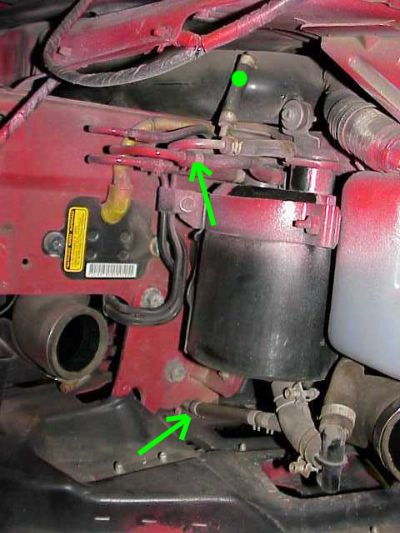
*Pic courtesy of Robo's website
2) AIV system
-The AIV system is a system put into to place in early years, 90-92 Z32's, to cool down the cats from excessive heat. A nice side benefit of removing the system is that is cleans up a lot of area under the engine bay, eliminating a lot of confusing vacuum lines. There can me some idle concerns with removing this system, and you should direct yourself with getting familiar with this delete how-to. Here is a link to Robo (Sebrings) very easy to follow delete from his website - La-Z-Link
Total assembly weight - 9.3lbs (Front weight area)
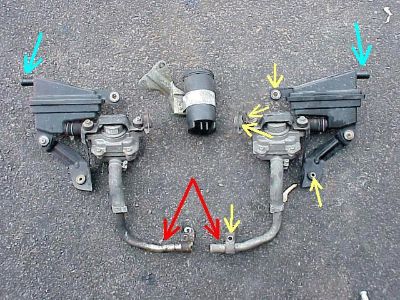
* Pic courtesy of Robo's website
3) Downpipes, Midpipes and Cats
It may seem like we are jumping off subject a bit but we are not, kinda. For the 90-92 owners, this mod is perfectly in line. Since we have now eliminated the AIV system, the need for elimination of heavy stocks cats/pre cats and downpipes, for better more free flowing parts comes into play more logically. Since the elimination of AIV's cools down the supporting emmision systems, it is logical to replace these items in this step. This is just suggestion, as some people have gone many miles later with no problems, but this is what has worked for a lot of other major tuners that I've spoken to over the years. As most choose a look or a sound for their exhausts, now the realization for purpouse modding comes into play. I won' touch to much on this due to fact that there are way too many systems available and too many variations of exhaust systems (Specialty Z downpipes/midpipes, Stillen, Ebay items, and so forth.) But the realization of swapping a heavier stock unit can be realized after simply holding the items in your hand. If you want to get more familiarized with knowledge in this department I would recommend checking with Greg Dupree of Seb over at Specialty Z as they guys make their living producing and selling quality exhaust parts. Personally I went to set of Specialty Z downpipes and midpipes vs stock downpipes and cats. I came out with a full 22lbs difference.
Total assembly weight - VARIES / 10-20lbs for NA's (NA midpipes) and 15-30lbs (TT downpipes and midpipes) 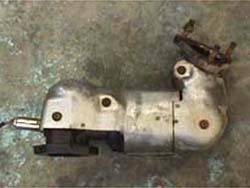 
* 1st pic courtesy of TT.net FAQ, 2nd pic courteys Specialty Z website.
4) PRVR System
- The Pressure Regulator Vacuuum Relief (PRVR) isn't much of a bypass to eliminate weight but rather an engine cleanup and preventive maintenance. But it does allow for simplicity of vacuum lines under the engine bay and the drivers fender. It can sometimes cause problems in the later years of Z life, hence the replacement and preventive benefit. Eliminating the system kills out 1 vacuum soleniod, canister and associated brackets/hoses. Robo (sebring) did a great writeup on this again from his website. The link can be found on his site that I listed in 1 and 4 above.
Total assembly weight - 2.1lbs (Front engine weight)
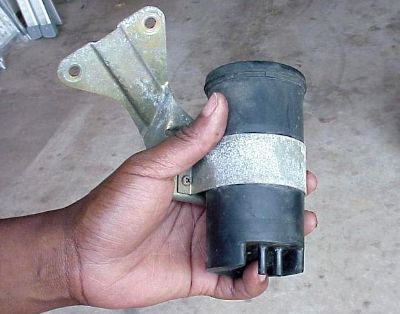
*Pic courtesy of Mr. Robo website.
5) HICAS Bypass
The High Capacity Actively Controlled Suspsension (HICAS), as mentioned previously comes in two version hyrdraulic and electrically controlled. The systems only came on TT versions. The hyrdaulic system works off the powersteering system to recieve fluid. This fluid is fed into lines that run all the way to the rear of the vehicle and into a fairly large actuator. The electric unit still has an actuator but is controlled via an electric controlling module. The 90-94 TT's came with the hydraulic unit and the 95-96 TT's were installed with the electric unit.
There are two schools of thought in reference to these units. Basically the Fors and the Against. Some traditionalist keep the system stating it gives the Z a more controllable aspect on high cornering while others argue the same fact, stating the Z32 becomes less controllable via corrective steering at high speeds. I am not here to argue either one, just to state that if you wish to pull the unit, here are the weight facts from my personal experience. There are also two ways to eliminate the system. The entire system as a whole can me removed, requiring a replacement of the TT powersteering pump to a NA powersteering system that does not have feed lines to the rear HICAS actuator. This obviously removes more but requires more work. In an nutshell, converting the entire system to an NA PS system will cut out the HICAS alltogether. Or you can simply eliminate the HICAS actuator with an eliminator kit (Stillen, Powertrix, etc) and loop the hydraulic lines into themselves. Here is a link to process from our FAQ section - La-Z-Link. Total assembly weight - 71.6lbs (Front and rear weight area)
*Note this is full elimination of the system - Hyrdraulic actuator, full lines, difference in NA/TT PS pumps, fluid difference (just over 1 extra pint), brackets and the front hydraulic syleniod). This was everything that weighed, just under the illlusive 77lbs that people claimed via internet chatter over all these years. Total assembly weight - 31.7lbs (Rear weight area)
* Note this is just the rear actuator bypass coupled with a Stillen HICAS eliminator kit.

* Pic courtesy of VTF post by 300zx90 (CO)
6) EGR system
The Exhaust Gas Return (EGR) is again a small system that, in this case, takes a small amount of exhaust gas and redirects that gas back into the upper plenum for emmission reasons. For those that are aware of it's location, it is dead center in the rear portion of the engine. The popular approach is to pull the system while the engine is out but some have been known to pull it while still in the vehicle with as little as only the plenum off. God bless them. None the less, the system is still one that can simply be removed for simplicity and shave a few extra pounds as well. 300Degree sell a bypass kit that is very simple to use and I highly recommend that. For more info on how to eliminate it, by Robo (Sebring) website, mention earlier.
Total assembly weight - 4.3lbs (Front engine weight)
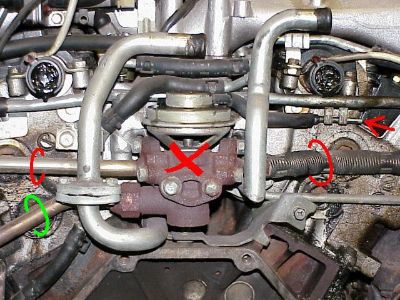
* Pic courtesy of Robo's website **** Body panel and exterior panel replacements ***** 1) Foglight
The stock foglights are one of the first and simplest body parts able to be eliminated to shave some weight from the front of the vehicle. Eliminating foglights is fairly simply but does require removal of the front bumper. This will allow removal of the sealed beams, removal of the housing that attaches to the rebar and all associated hardware. For some, the look of a giant hole in their bumper is not desirable, so ducts can now be inserted in their place to route air to wherever desired. Most mount them as additional air to the SMIC' or even the brakes. Companies like Powertrix offer fiberglass and carbon fiber options to take the place of the foglights additional position. Total assembly weight - 6.7lbs (Front area weight)

2) Hoods (just a note)
It's been argued many many times here on TT.net about how the aluminum hood is just as light to a CF hood arguing that it is not worth going to CF. And the answer is that the stock hood is pretty good to start with and with which to stay with for that matter. The CF hoods vary from manufacturer but there is only a fraction of difference between a oe aluminum hood weight to a CF versions weight. The CF hood that I weighed only came in at less than 1lb difference. Hardly worth the money and effort. So, IMO it is not worth wasting the money. Also note that CF constructions are usually very poor in comparison to the aluminum hood. It has also been noted that some CF hood even bend and become mis-shapen over excessive wear to heat. I can't comment on fiberglass as I have yet to have a fiberglass hood to verify it's weight but I am sure the CF would be superior to it. So why did I even mention it? Well, there is another hood out there. The aftermarket replacement steel hood. *cringe* The steel hood weighs three times the weight of it's aluminum counterpart. These hoods were normally cheap replacements to alumimun hoods in the event of replacement after an impact or say something like hail dmg. So, if you have a steel hood, swap it for a aluminum one. How do I know if I have one? Simple. Use a magnet. If it sticks, you got steel. If it doesn't stick, you got aluminum. This may help cut weight on those that don't know where they stand with their own hood.
3) OE TT wing vs AM TT wing
For many years, us poor Z32 guys had to either run wingless or hunt down an OE replacement in the event of "wing rott". The metal that ran through the wing would sometimes rust and then eventually the wing would begin to come apart and crack. AM replacement existed but a true OE replacement for the heavy foam based wing, there was not. Yuichi of KurumaZ developed the first true OE replacement in a fiberglass option, eventually Yuichi used premium vendors like Concept Z Performance as dealers for these products. And now to this day, they are a great replacement options that can save pounds simply due to material differences. 8lbs is what the KurumaZ wing comes in at as opposed to the stock OE wing which, per COZ, tips the scales at around 16lbs. Powertrix has now developed their version of the stock wing as well, weight is nearly identical. I have not tested any other AM wings, just this version as this is all I had at time of weighing. Total assembly weight - 8lbs (Rear weight area)
*Replacing OE with KurumaZ wing, figures via COZ.
 * Pic courtesy of Powertrix website. * Pic courtesy of Powertrix website. Total assembly weight - 16.4lbs (Rear weight area)
*Removing wing/hardware all together. Note addition of 3rd brake light needed. Weight is all inclusive. 4) Rear hatches
For a long time rear hatches were not available to the Z32 community as an viable option. Some would go so far as to gut internals of the rear hatch in early days, to shave weight. Escort had developed a rear hatch in fiberglass first, as far as I know. Z1 recently picked up the distributation of the hatch. That hatch comes in at 14lbs without glass and eliminates the 3rd brake light as well, taken from Z1 website. Powertrix has also developed both CF and fiberglass versions of the stock hatch, which are currently in small supply but available. The CF Powertrix version came in at 14.6lbs on my hatch that I recently purchased, and Powertrix states the fiberglass version is right at 14lbs as well. So, currently there are 3 variations of the hatch at this time. All coming in at about the same weight. Really the only differences in the three, being construction and need for a 3rd brake light. Note that the rear wiper arm hole is now filled on all 3 options. Total assembly weight - 48.2 (Rear weight area)
 
* 1st pic from Z1 Motorsports website, 2nd pic from my project LOWFATZ. As I've ran through these weight reductions, I have slowly gone from minor weight reductions to much more intensive reductions. As we progress into part 3, there is a two more areas that I wish to touch on. Engine/drive train reciprocating mass reductions and extreme body reductions, which will of course be for those folks planning on making their Z32 a full out track vehicle. Keep in mind the sky is the limit with some of these reductions and there is always someone out there pushing the limits. There are some really great minds on TT.net that know much more about these items than I do, I am just trying to give a rough idea of what is available and what works for me. Kudos to them for the development and drive they give to the community. Part3 will include - Reciprocating Mass - 1pc driveshafts, lite clutch/flywheel combinations, Pulleys (UR vs Harmonic), Brakes, wheels.
Extreme weight reductions - Fiberglass doors, Speed glass/Lexan, sound deadening removal, AC system removal,
Hope this helps someone out there.

|

